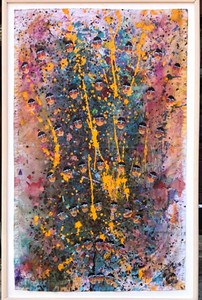
Dee Shapiro
Illustrate Illusion, 1990
Oil painting on panel
Signed twice: once on the front, and once on the back, with copyright, date and title
Unique
Frame included
Oil on panel painting, unique
Signed twice: once on the front, and once on the back, with copyright, date and title
Provenance: Acquired from the estate of renowned New York art dealer Andre Zarre
Double framed in a white wood frame
Measurements:
Framed
14.5 inches by 16.75 inches by 1.75 inches
Artwork:
7.75 inches by 9.5 inches
DEE SHAPIRO BIOGRAPHY
Biography • Dee Shapiro (b. 1936)
Dee Shapiro was born in Brooklyn, NY. She studied art and psychology in college, receiving both a BA and an MA from Queens College (1954-1960). There she studied color with abstract artist John Ferren. A semester in Mexico in 1956 introduced her to bright patterns and colors, as well as the murals of River, Orozco, and Siqueiros.
From 1960 to 1968, Shapiro taught, got married, and raised kids. She still made time for art, taking painting classes with Richard Mayhew at the Brooklyn Museum. When she and her family moved to Great Neck in 1968, she founded Central Hall, the first women’s cooperative gallery in Long Island. Shapiro was also a contributor to Heresies, a feminist publication on art and politics.
Shapiro explores the intersections of pattern, geometry, nature, and craft in her work. As a child, knitting instilled an interest in how patterns develop from small individual components into larger compositions, as well as the importance of counting and learning numerical patterns. Her first abstract paintings in the 1970s were based on mathematical concepts, particularly the Fibonacci sequence that generates the Golden Mean. Early works included arrangements of ordered tally marks in bright colors or gridded diagrams of the Fibonacci sequence. Shapiro soon moved to patterns that allowed her to use color intuitively within a grid. She built up the surface of the paintings by squeezing paint directly from the tube to create a woven or knitted texture.
Shapiro was included in Pattern Painting at PS 1 in 1977, organized by noted curator John Perreault, which presented work by twenty-two artists working in the P&D Movement. The Everson Museum in Syracuse, NY organized a solo exhibition of her work in 1981. Her New York dealer was Andre Zarre.
Shapiro was a member of the Criss-Cross Artist Collective, founded in 1974. The group originated in Boulder, CO as artists interested in Systemic Pattern Painting or Structuralism. The group expanded into New York, California and Europe with its art journal Criss-Cross Art Communications, published from 1974 to 1981. They aimed to foster group work, interaction, integration, and synthesis. The artists were interested in geometry and pattern yet worked in a variety of art forms including text, sound, film, and dance. What connected the artists were: a capacity for visual organization; valuing the importance of pattern on perception and knowledge; and a methodology of system, ordering, and counting. The artists that crossed over with the Pattern and Decoration Group were Dee Shapiro, Gloria Klein, and Tony Robbin. In a 1982 catalogue for the exhibition Developments in the Criss-Cross Group held at the Alain Bilhaud Gallery in New York, the artists had a two-page spread to discuss their work. Shapiro illustrated her influences and intent with decorative patterns, mathematical patterns, and diagrams of her thinking process. She wrote out the following words to form a square:
VISUAL, TEMPORAL
SPATIAL, ORDER
WITH SURPRISE
SENSUOUSNESS
PLAYFULNESS
This seems an appropriate selection of words to capture the way Shapiro’s paintings are both strict in their patterning and a pleasure to view.
Throughout her career, Shapiro used line as a basic unit to explore repetition, variation, symmetry, and pattern in both abstraction and figuration. Recently Shapiro was included in the exhibition Process & Delight: The New P&D, curated by Patricia Fabricant and Jaynie Crimmins, at Equity Gallery in New York (2023).
Dee Shapiro’s work can be found in the collections of: Buffalo AKG Art Museum, NY; Birmingham Museum of Art, AL; Chrysler Museum, Norfolk, VA; Dayton Art Institute, OH; Everson Museum of Art, Syracuse, NY; Guggenheim Museum, New York, NY; Herbert F. Johnson Museum of Art, Ithaca, NY; Hood Museum of Art, Dartmouth College, Hanover, NH; Mint Museum of Art, Charlotte, NC; Museum of Contemporary Art, Los Angeles, CA; The New Museum, New York, NY; Newark Museum, NJ; Oklahoma City Museum of Art, OK; and Spencer Museum of Art, University of Kansas, Lawrence.
-Courtesy Wigmore Fine Art









